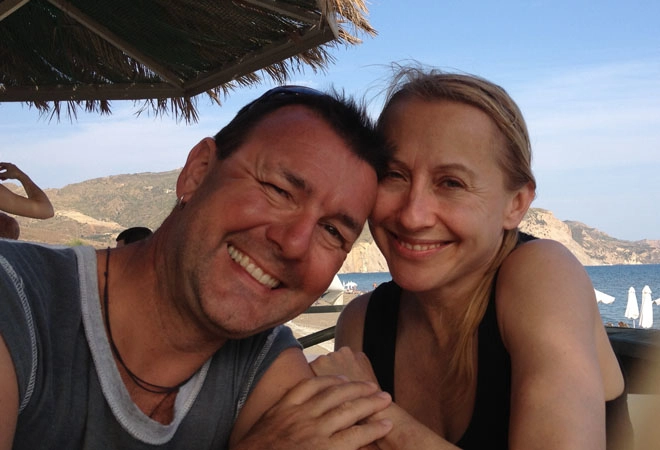
Ingrid Gardiner was just 51 when she died in October 2017 after spending the last six weeks of her life at the Hospice. Here, her husband Carl, 54, talks about Ing’s illness and how the Hospice has supported the whole family…
“Ing and I had been together for 27 years and all her life she’d been a runner, jogging 4-6k every day of the week, playing football in the Raiders Ladies team, never smoking, hardly drinking. She was really fit and healthy.
But in May 2014, at the age of 47, she went for a routine mammogram at the mobile screening unit in Berkhamsted where they discovered a 4.7cm lump in her breast.
We were horrified but within a few weeks, she’d had successful surgery to remove the lump, which was stage 2 breast cancer. A few weeks later, they found some leakage to her lymph nodes and she needed axillary clearance but when oncocyte testing showed the likelihood of the cancer recurring was very low, she decided not to have chemotherapy and within a couple of months, she was looking amazing in her bikini on a family holiday to Zakynthos with our son Louis, who was 12 at the time.
It was at the end of 2015 that she started having problems running, complaining of pain in her hips and pelvis. It didn’t occur to us that anything was seriously wrong, we just thought she’d overdone the training, but when physio didn’t help and the pain got worse, we called the oncology team at Mount Vernon.
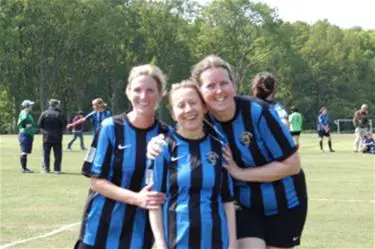
They immediately got her in for CT and MRI scans and in February 2016 we were told the devastating news that the cancer had spread to her bones and liver and it was terminal. The average prognosis for metastatic breast cancer was 23 months, they said. Devastation just doesn’t cover it. I don’t know how I drove us home without crashing.
They sent us home laden with painkillers, anti-sickness drugs and a leaflet about The Hospice of St Francis’ Spring Centre and it all began – starting with ten days of emergency targeted radiotherapy on her spine, hospital appointments, blood tests and more scans.
From working as a sound engineer and travelling the country, I became her carer.
Initially the hardest task was trying to keep track of all her new medications: she couldn’t keep any of them down, so knowing what she’d absorbed and whether to re-administer them was a real headache.
I was on the phone the whole time just trying to manage this poor girl. I felt stuck and quite isolated and by April 2016, she’d lost a lot of weight and was going downhill fast. Our GP referred us to the Hospice. Fay, from the Hospice’s community nursing team, came to see Ing at home to assess her and within days, she was admitted as an inpatient to try to get on top of her symptoms.
I was in such desperate straits it was just nice to have someone to pick me up - it felt like finally someone was on my side. It was such a lovely place – everyone was so kind and Ing had her own private room with views onto beautiful gardens. They tweaked her drugs, which they administered through syringe drivers, meaning she could keep them down. She could also eat again and keep food down – all of which had a stabilising effect.
Six weeks later, they turned her new drug regime into pill form and she was able to come home. Having had so many people to call before, now there was just one – Caroline, Ing’s Clinical Nurse Specialist and she’d call the GP or Ing’s consultant and because Caroline’s Caroline and spoke in clinical terms, they’d listen.
The drugs kept everything at bay, some of the tumours even started to shrink and life went on for a year. We decided to go veggie as Ing’s system seemed to cope better without meat. She joined the Hospice’s Spring Centre Nordic Walking group, had relaxing aromatherapy massage and attended the Hospice’s Mindfulness classes, which all helped her stay positive.
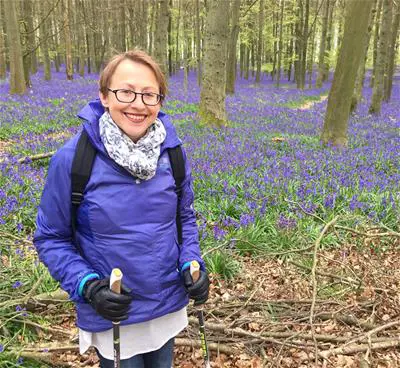
Then, a scan at the beginning of 2017 revealed lots of other new little cancer speckles all over her liver. She decided to try chemotherapy as she thought she might buy some time with Louis, but straight away she had such a violent reaction and was very ill. She didn’t want to go out, she didn’t want to see anyone.
In the July, she went into a tail spin, being violently sick, feeling dizzy and nauseous and was in and out of hospital. She came up to the Hospice for a short stay for couple of weeks in an attempt to stabilise her but once back home again, the symptoms just got worse.
While she was at the Hospice, I was put in touch with the Hospice’s Carers’ Support team, who suggested I get some counselling and I started seeing one of the Hospice’s psychotherapists, Charulata, who I really liked. The whole experience is incredibly isolating and even though you are with a partner, your role changes. You change from husband to carer so to have someone to talk to was very useful.
Ing saw Kimberley, another of the Hospice’s psychotherapists and Jo, a support worker in the children’s team, for counselling too. We were going to have joint counselling but having it separately gave us both a space where we could say things to our counsellors that we couldn’t say to each other.
I was constantly trying to put on a fake smile just to keep everything together, trying to juggle work, clean the house, get Louis up and out to school and be there for Ing. Just a listening ear and advice were so welcome. I did have a major crying episode with Charulata before Ing died because I’d kept it all in. I just felt I couldn’t breathe - as though I was suffocating. I had to run out into the gardens for air and she came and found me.
From that perspective, the Hospice was like a safety blanket for both of us. It was a place of sanctuary – especially for Ing after her chemo. She was in such a mess at home, and the Hospice was the only place that could stabilise her and make her feel comfortable. Also because the Hospice was involved early, by the time it got desperate, they weren’t strangers.
We managed a little holiday together in Lyme Regis at the beginning of September but when we got home her symptoms worsened again.
She went up there for a blood test to save her going all the way to Watford General but the nurses took one look at her and said she needed to come back in. She was reluctant because we both knew it would be for the last time. There were lots of tears but luckily a bed was available.
We saw Caroline and Dr Neil Pender, the Hospice’s Palliative Care Consultant, who was lovely. Neil really got Ing. She confided in him and he was our protector. The whole medical approach was holistic which is what medicine should be.
I was up there every day, two or three times a day, bringing stuff from home, watching movies and walking a lap round the gardens with Ing until her mobility stopped her from walking any more.
She died at the beginning of October.
We watched the last breath leave her body. I held one hand and Louis held the other. It was awful, but it was as good as it could have been. It just seemed so unfair. She did everything right in terms working hard and keeping fit – she didn’t deserve any of it.
Naively, I thought I’d had such a long time to prepare for it that I’d know how I’d feel, but it was such a shock and there were suddenly such an overwhelming amount of things to do. Everyone wants paperwork but you don’t have the energy to lift a teaspoon.
The worst part is the simple fact that she’s not here. I have drawers full of shoes and an office full of her paperwork that I haven’t got the heart to go through and there are still people who don’t know. who I haven’t told. My life has changed beyond all recognition. I miss her all the time. I don’t miss ‘cancer Ing’, I miss the one I was with for 27 years who was very hard to recall for the longest time.
Louis is dealing with it by spending time with his friends and having lots of sleepovers but since Ing died, he’s also had support from the Hospice. He had 12 sessions with Jo, the same children’s support worker who supported Ing, which gave him an outlet that wasn’t me. He’s a very keen runner, just like his mum and now he runs on her old running routes, which is his way of connecting with memories of his mum.
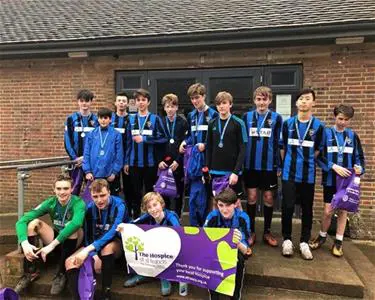
In March 2018, he and more than 50 fellow team-mates from the Raiders Under-15 squads completed the five-mile Berkhamsted Fun Run in memory of Ing, so touched were both parents and players by her passing. Ing would have got such a kick from knowing that Louis and the lads were doing it for the Hospice, raising over £1,700 to help fund its care.
I had misconceptions about the Hospice like everyone else - and everyone I’ve spoken to is the same. People think Hospices are places where you go to die but what no-one realises is that hospices are places where you go to live.
I can never thank the Hospice enough for everything it did for us. It was our rock and made the most unbearable time in our lives bearable.
Even in the midst of it all, I kept thinking of everyone in the world who doesn’t have access to this kind of care and how lucky we were to have it. They’re a huge missing part of the NHS. If hospices didn’t exist, where would everyone go? There’s nowhere else that administers long-term outpatient, home and inpatient support like they do.
Ing didn’t want to die at home and if you have to leave this world, this was the very best way to leave it.”





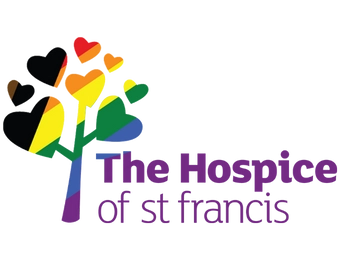
Share Article